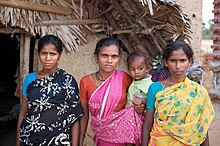User:Ankitak03/sandbox

Caste discrimination in the United States
History of caste in the United States [edit]
[edit]Caste is a birth-based social stratification system.
Historically, the dominant caste Hindus and Sikhs have been the ones to acquire citizenship in America. In 1923, A.K. Mozumdar and Bhagat Singh Thind argued that they passed the whiteness test because they were caste Hindus and had pure "Aryan" blood.[page needed]
In 1910, the Asiatic Exclusion League argued that Asian Indians should be denied citizenship through naturalization. The league described Hindu ancestry as "enslaved, effeminate, caste ridden, and degraded" and Hindus as the "slaves of Creation".[page needed] Such racist rhetoric formed the idea of the "Hindoo invasion", an iteration of the "Yellow Peril."[page needed] In 1953, W. Norman Brown, founder of the Department of South Asian Studies at the University of Pennsylvania, wrote that "a large number of Americans...have a picture of India ... where everyone is a beggar and caste is more important than life".
In recent times, caste discrimination has followed the immigrants to the US from India, Nepal and other south Asian countries. There are more than five million South Asians living in the US.[1] Despite being one of the fastest growing immigrant groups[2], it has been mostly underreported despite its influence on job opportunities and marriage prospects among south Asian immigrants. Indian migrants account for a large number of high-skilled workers in STEM fields, leading to an issue of caste discrimination in the workplace in areas such as Silicon Valley.[2] Thenmozhi Soundararajan, executive director of Equality Labs, says, “Caste has been here (in the US) for a long time. Wherever South Asians go, they bring caste."[2]
SB403
In September 2023, the California state senate passed a bill banning discrimination based on caste. SB403, authored by Democratic Senator Aisha Wahab, is a legislative initiative in California that aims to make the state the first in the nation to include caste discrimination in the list of protected rights.[3] The bill defines caste as “an individual’s perceived position in a system of social stratification on the basis of inherited status”, which can be determined by several factors including the “inability or restricted ability to alter inherited status; socially enforced restrictions on marriage, private and public segregation, and discrimination; and social exclusion on the basis of perceived status.”[4] SB403 proposes amendments to California's housing, labor, and education codes to explicitly prohibit discrimination based on one's ancestry, which notably includes caste.
Nirmal Singh, a physician from Bakersfield, California, touches on the impact of SB403 for South Asians: "“It has become psychological trauma that carries over, one generation to the other generation. “This was a very important bill for us.”[5]
Psychosocial Toll

Caste-based discrimination imposes psychological distress on its victims, especially from lower castes. Dalits suffer at the hand of discrimination, being referred to as "untouchable" and "dirty".[6] Dalits are often bullied by upper-caste classmates and treated differently by teachers, which is trauma that translates from one generation to the next.[5] South Asians report experiencing diminished self-esteem, feelings of isolation, and enduring anxiety and fear. The first extensive study of caste and its effects in the US found that those from lower castes "fear retaliation and worry about being "outed" and hence "hide their caste."[7] This fear of being outed can manifest in several ways; for example, some families opt to change their surnames to one considered more "caste neutral" (i.e. "Kumar", "Singh", "Khan") in order to avoid ridicule and isolation.[8] The long-term impact on mental health can be severe. However, psychological intervention from the lens of casteism has lagged behind. Research of the Dalit community in Nepal demonstrates that social inequality by way of economic, social, cultural, and psychological stress all contribute to their experience of diabetes; Dalits used diabetes to relay "psychosocial stress through somatic symptoms." Diabetes and other illnesses disproportionately affect those of lower castes, and the causes linked to intergenerational poverty, lack of access to healthcare and education, and other stressors which prolong diabetes impact the mental health of these individuals.[9]
- ^ "Demographic Information | SAALT". Retrieved 2023-10-09.
- ^ a b c Pepper, Harmeet Kaur,CNN Illustrations by Max (2020-09-04). "Even in the US, South Asians say caste has proved hard to escape". CNN. Retrieved 2023-10-09.
{{cite web}}:|first=has generic name (help)CS1 maint: multiple names: authors list (link) - ^ Osgood, Brian. "California passes bill banning caste-based discrimination". www.aljazeera.com. Retrieved 2023-10-09.
- ^ "Bill Text - SB-403 Discrimination on the basis of ancestry". leginfo.legislature.ca.gov. Retrieved 2023-10-09.
- ^ a b Yang, Mary (2023-09-27). "'Once we win California, the nation is next': what a caste discrimination ban means for Americans". The Guardian. ISSN 0261-3077. Retrieved 2023-10-09.
- ^ Bajoria, Jayshree (2014-04-22). ""They Say We're Dirty"". Human Rights Watch.
- ^ "The divisive debate over California's anti-caste bill". BBC News. 2023-06-09. Retrieved 2023-10-09.
- ^ "Using surnames to conceal identity". The Times of India. 2009-02-21. ISSN 0971-8257. Retrieved 2023-10-09.
- ^ Thapa, Tirtha (24 July 2014). "Living with Diabetes: Lay Narratives as Idioms of Distress among the Low-Caste Dalit of Nepal". Cross-Cultural Studies in Health and Illness. 33 (5): 428–440 – via Taylor & Francis Online.

